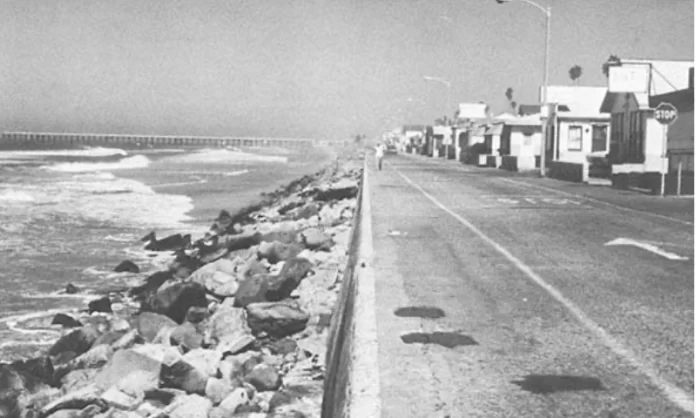The City of Oceanside is taking important steps to decelerate coastal erosion with an innovative Coastal Zone Management Program. Oceanside has an 80-year history of beach erosion resulting in large part from the construction of the Camp Pendleton Boat Basin in 1942 and the Small Craft Harbor in 1963, collectively referred to as the Harbor Complex. The Harbor Complex traps sand to the north which limits sediment inputs into the Oceanside Littoral Cell and deprives Oceanside beaches of sand from up-coast, natural sources.
In 2020, the City conducted a year-long preliminary engineering evaluation to determine a suite of solutions to lessen long-term beach erosion and mitigate the effects of the Harbor Complex. The resulting Feasibility Study (Phase 1) concluded that 1) a high-quality source of sand, coupled with a beach nourishment program, should be developed to provide more consistent beach nourishment opportunities, and 2) retention structure(s) are most effective as a means of retaining placed sand since historical surveys and observational data reveal that placed sand alone does not persist on many of Oceanside beaches. At a City Council Workshop in August 2021, the Council voted to move into the next phase (Phase 2) of the Study, to design and permit a sand nourishment and sand retention pilot project. The Council direction requested flexibility in a project design that will yield maximum benefits to all of the City’s beaches.
Phase 2 of the Sand Nourishment and Retention Pilot Project will involve 1) development of a consistent sand nourishment program utilizing a sand bypass method, locally-sourced dredged sand, or other regional sand nourishment method; and 2) design of a hybrid sand nourishment structure that mimics natural retention processes, such as those provided by a low relief reef or headland.
The City plans to solicit innovative design ideas for sand retention structures through a design competition process. Design competitions are a proven method for incorporating regional and local stakeholder input. All design alternatives will be required to meet minimum design criteria, which includes providing multiple benefits for the local community, downcoast neighbors, and natural ecosystems. The design competition is expected to take approximately one year and will include an extensive public engagement process, yielding a preferred and viable design that will be brought to Oceanside City Council for final approval. Following approval, final engineering, environmental compliance and permitting tasks will commence, which is expected to take up to two years. The pending contract for the design and permitting of the Phase 2 will cost approximately $2.5M.
The professional services agreement for Phase 2 will be reviewed by the Oceanside City Council on January 25, 2023.
In the interim period, Coastal Management staff has obtained necessary permits to enable streamlined beach nourishment to eroded areas of our coast when suitable sand from inland, offshore, estuary or lagoon sites becomes available. Stringent environmental regulations are in place to ensure that opportunistic, imported sand is compatible with the beach sites where the final deposition occurs. The permits will allow the City to place up to 150,000 cubic yards of sand annually to designated, eroded areas of the shoreline.
For more information, please visit the City website: https://www.ci.oceanside.ca.us/gov/pw/beach/coastal_management/default.asp


















